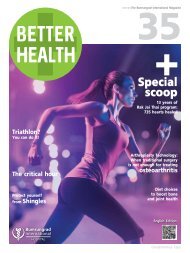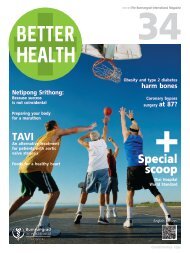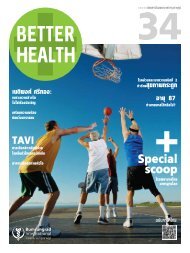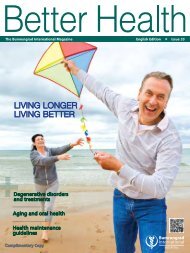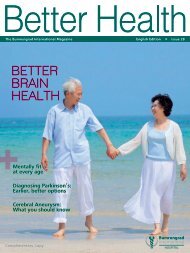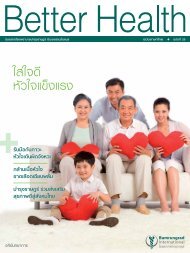Better Health 25 Eng
The magazine for patients and friends of Bumrungrad International Hospital, Thailand.
The magazine for patients and friends of Bumrungrad International Hospital, Thailand.
- TAGS
- bumrungrad
- hospital
- thailand
You also want an ePaper? Increase the reach of your titles
YUMPU automatically turns print PDFs into web optimized ePapers that Google loves.
<strong>Better</strong> flexibility and balance. Exercising an individual <br />
body part through its full range of motion helps stretch <br />
muscles. At the same time, the shifting of weight forward <br />
and back improves balance, a benefit that reduces the <br />
risk of falls, injuries and muscle pain. Yoga and tai chi <br />
are two of the best basic movement exercises. <br />
Improved heart and lung function. Aerobic exercise is <br />
one of the best ways for seniors to improve the function <br />
of their heart and lungs. For maximum results, increase <br />
the intensity level of each workout gradually until you <br />
reach your target heart rate (THR). For seniors, the target <br />
heart rate ranges from 60 to 70 percent of one’s maximum <br />
heart rate, a level that is lower than the THR for younger <br />
adults. During exercise, try to maintain your THR for <br />
about 15 minutes, and include aerobic workouts three <br />
times each week, or about every other day. <br />
“ Having reduced mobility doesn’t<br />
mean you can’t exercise–it’s a <br />
good reminder of the need to <br />
exercise so you can pursue a <br />
happier, healthier senior life.”<br />
Target heart rate<br />
= Maximum heart <br />
rate x 60% or 70%<br />
Maximum heart rate = 220 – age<br />
“An optimal exercise program encompasses these four<br />
categories, giving seniors a full range of benefits to health<br />
and physical fitness,” notes Dr. Suthee.<br />
Limited-mobility exercises <br />
Limited physical mobility doesn’t preclude most seniors<br />
from exercising; there are plenty of ways to achieve better<br />
health by exercising while seated or lying down. Lessstrenuous<br />
exercise is always better than no exercise at all.<br />
Seniors still have a great deal of influence over their postretirement<br />
health and happiness, beginning with a conscious<br />
choice to start living more active lives.<br />
Exercise made safer<br />
Many seniors worry about exercise jeopardizing <br />
their safety and increasing their risk for injuries<br />
and accidents. Whatever one’s age, there’s a right<br />
way to exercise and a wrong way. Exercising the wrong<br />
way causes painful injuries and potential health problems.<br />
Before starting any exercise program, be sure to follow<br />
these recommendations: <br />
Consult your doctor to confirm that it’s safe to start <br />
exercising; your doctor can recommend specific exercises <br />
best suited to your individual situation while ruling out <br />
the presence of any medical problems that may be <br />
aggravated by exercise. <br />
Build intensity gradually, starting with simple, short <br />
exercises that gradually increase endurance until your <br />
body can tolerate a 15- to 30-minute workout.<br />
Choose proper shoes and wear comfortable but not <br />
overly-loose clothing. <br />
Exercise in a safe environment; the floor should be flat <br />
and firm, and room temperature should be moderate, <br />
neither too hot nor too cold. <br />
10<br />
<br />
<br />
Choose exercises that you find enjoyable and that suit <br />
your physical fitness level. Early on, avoid resistance <br />
exercises in favor of low-impact activities like walking, <br />
cycling and swimming.<br />
Keep breathing normally; holding your breath or speeding <br />
up your breathing increases peripheral vascular resistance, <br />
which forces the heart to work harder and puts you at <br />
risk of high blood pressure.<br />
Allow sufficient recovery time between workouts. Consider <br />
switching to lighter exercises until muscle soreness subsides. <br />
Before beginning each workout, always warm up for about <br />
ten minutes to stretch your muscles. And don’t end your <br />
workout without cooling down for five to ten minutes. This <br />
reduces the risk of dizziness and fainting while allowing <br />
blood flow to gradually return to its normal rate. <br />
Avoid working out when you’re feeling tired. And it’s a good <br />
idea to end a workout if you feel overly tired, such as when <br />
breathing heavily makes it difficult to speak normally. <br />
Stop your workout and get medical help if you experience <br />
shortness of breath, chest pain or dizziness.




